Here is the Volume 3 of Hockey from When you watch something, visit us first! Mr. Manabu YAMASHITA, former Coach of Japanese men’s national Hockey team “Samurai Japan”, told us about the Offense and Defense around the Circle this time. This is the combined version of Part 5-1, 5-2 & 5-3 on our YouTube channel.
In Vol.2, we learned how the Hockey match goes and the unique Stick work.
This time, with the cooperation of Japan Hockey Association, Mr. Manabu YAMASHITA, former Coach of Japanese men’s national Hockey team “Samurai Japan”, told us about Offense and Defense around the Circle, which is unique and characteristic in the Hockey matches. Mr. YAMASHITA was the Captain of “Samurai Japan” at Tokyo 2020 Games, and is now back in active and aiming to be a member of it again.
We would like to thank Japan Hockey Association, especially Head Coach of Samurai Japan, Mr. Akira TAKAHASHI, for their great help in making this video. We would like to express our sincere gratitude.
.png)
Part 5-1: Offense and Defense around the Circle – Concept of Offense (OF) –
In Hockey, I think Offense is more advantageous in the Circle than Defense. Even if Offense commits a foul in the Circle, there is not much risk if they go back quickly as such foul happens at the deepest point on the Opposing side.
On the other hand, if Defense commits a foul, there is a much risk that the opponent will score, or the Penalty Corner, which is unique to Hockey, will be given and the Defense will be forced to be with a disadvantage, therefore, I consider that the Offense is advantageous. So I think the first priority on Offense is to get the ball into the Circle.
Concept of Offense (OF)
The Offense (OF) players hit the ball into the Circle toward this area, which is near the goal. They hit the ball and another player touches it in this area and deflect it toward the goal, and in Hockey, there are quite a few goals scored from this area.
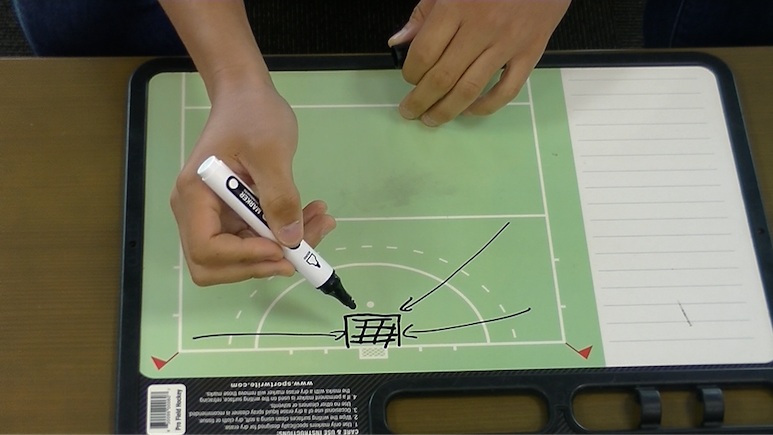
That being said, the Defense (DF) will also try to keep OF players from entering the Circle, so that is when OF player hits the ball. It is good if OF player can hit the ball hard enough to get it in, but there are always some DF players to block the Circle on the route of the ball, so in such cases, they attack from the side.
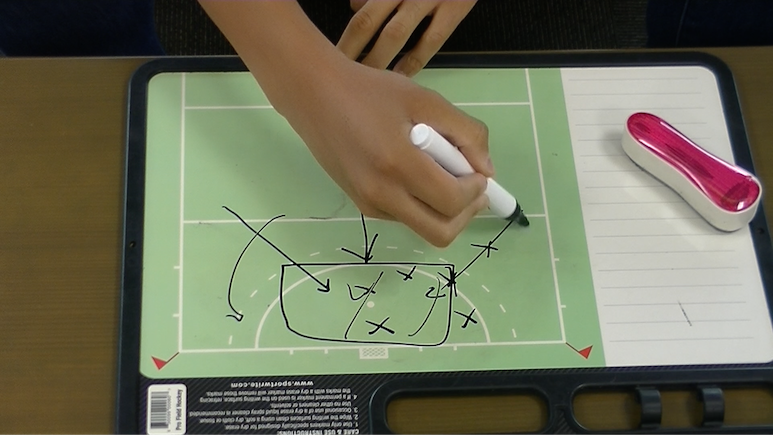
so in such cases, they attack from the side. The more people in the Circle, the more the DF player touches it and it hits another DF player’s foot for a foul, or the ball is too fast to stop and it hits the DF player’s foot, etc. and we really never know what will happen.
There is also the matter of sending the ball into the Circle anyway.
And, OF players can enter the Circle from anywhere, but it is still hard to score from this angle of this area. It is very difficult to score a goal from this area where there is less angle, so in these areas, OF think about taking a Penalty Corner that OF can send the ball from here and shoot from in front of the goal. Many teams have a static of trying to get a Penalty Corner by inviting a foul rather than shooting from such area with less angle.
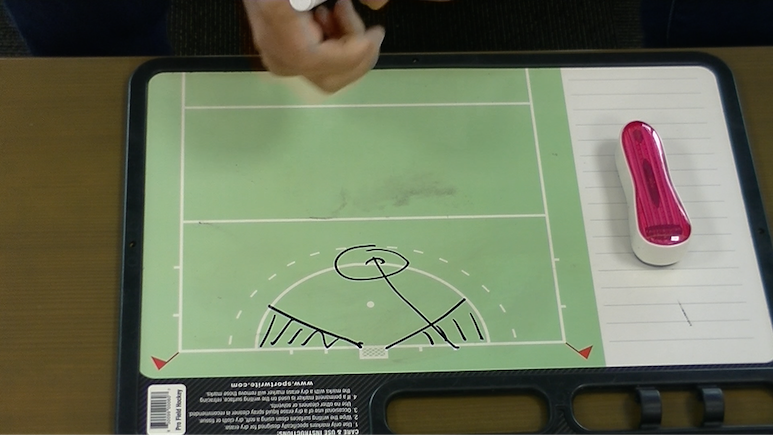
When the ball is this area, if there are only a few opponents, OF may use their individual skills to dribble past them and enter the Circle, but on the other hand, if OF is here with the ball, the opponents will also come, so to attack from the opposite side away from this narrow area is the theory of Hockey. I think the basic theory of Hockey is to attack where the DF players are not.
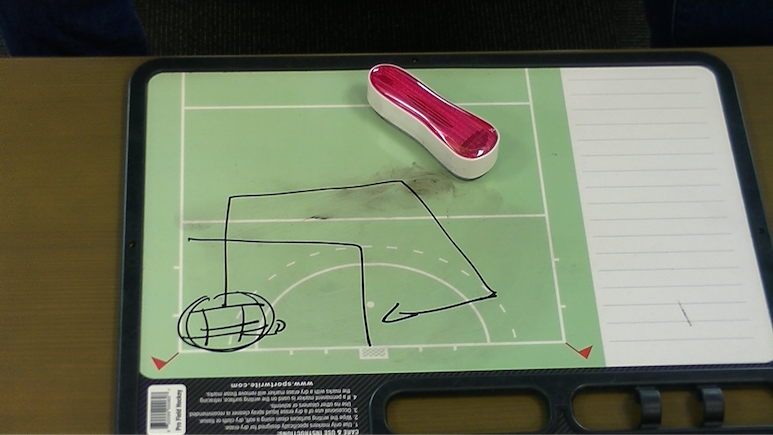
Of course, if the OF moves to the left once and then attacks from the right, it is quite difficult to defend the left side in Hockey, so some teams basically attack from the right, however, since it is often to be defended by the DF when attacking while taking fouls in a crowded area where players are concentrated, I think it is quite common to attack from a wide area on the opposite side.
Part 5-2: Offense and Defense around the Circle – Tactics around the Circle –
Touch Shot
If the Offense (OF) player touches the ball even a little in the area near the goal, it will be a goal. It is very easy to change the course of the ball if it is fast and strong, so that it really only needs a slight touch to go past around the goalkeeper’s head.
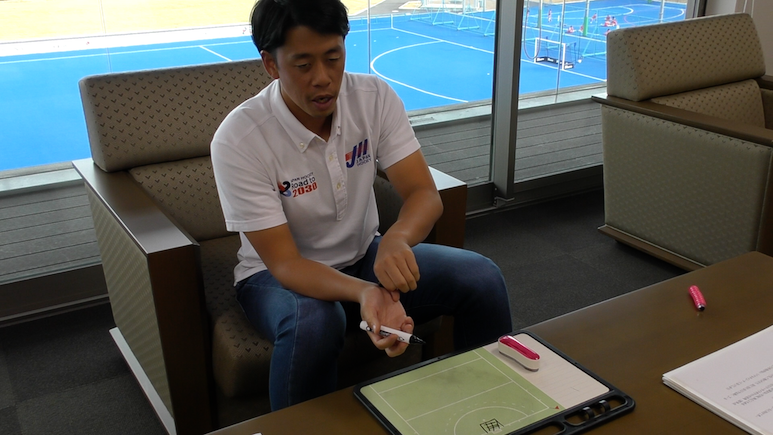
It is quite difficult for both goalkeepers and Defense (DF) players to respond to such change, so I think that the feature of Hockey is that no matter what angle the ball is hit from, as long as the player has a good touch, the probability of scoring is high. Even though the ball position is less angle, but if OF player has a good touch on it sent from there, it will go into the goal. The initial course of the ball is off the goal, but that touch is good enough to get it into the goal. So, conversely, it is important for the DF player to get in front of the opponent and not let him touch the ball.
A high level of concentration is required for the DF players in the Circle, as a player behind another player is often surprised by an unexpected ball, or the ball rolls in and the players do not see it and hit it on the leg, resulting in a Penalty Corner.
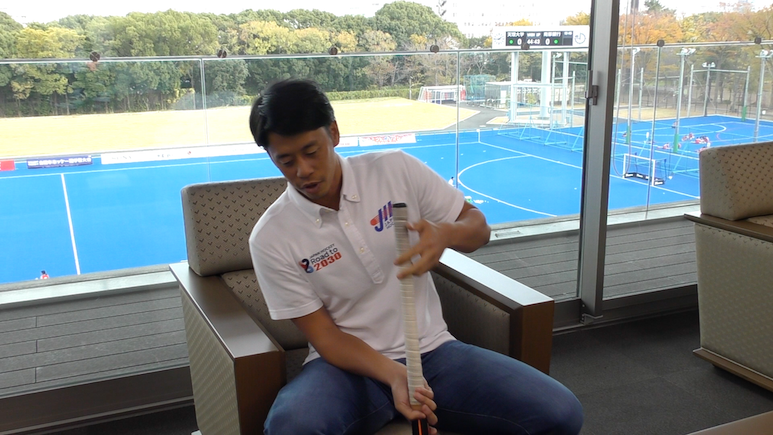
A slight change of the direction of the face of the stick can give the OF a chance to score, while it can be fatal for the DF, so the DF is at a great disadvantage in the Circle.
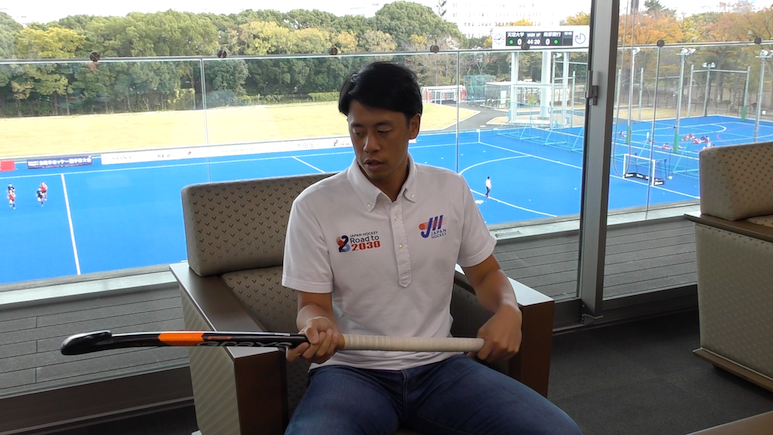
I think there is a lot of tactics in the corner kicks of Soccer, but you can also see this type of play which is quite interesting in Hockey as well, and please do not miss some goals which we cannot easily recognize who scored the goals.
Utilization of the area around Far Post
If the ball is here, this is the “Near Post”,
.png)
and this is the “Far Post”.
.png)
For example, if the ball is here on the right side, one option is to dribble and past the opponent, the other is to cut in while advancing like this and go to the place with the angle and shoot. Or they could take a Penalty Corner.

And since the player is not alone, he/she often dribbles like this and then to send his teammate here the ball for a touch shot. The key is behind the Goalkeeper.
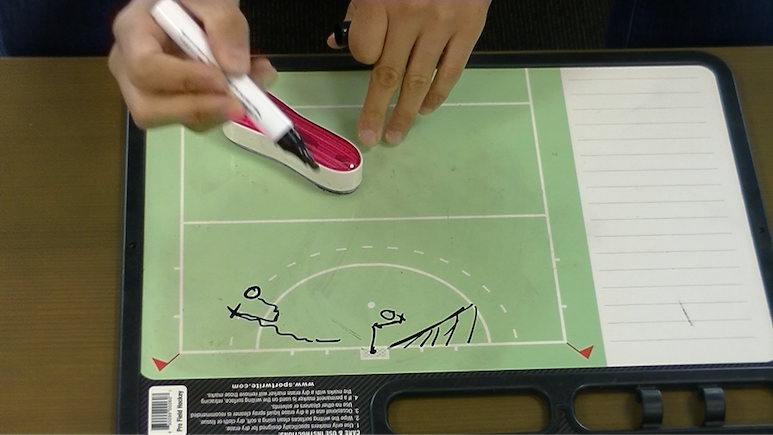
This is a worldwide commitment, including Japan. Whenever some player enters the Circle and shoots or dribbles, another player should always wait at the Far Post.
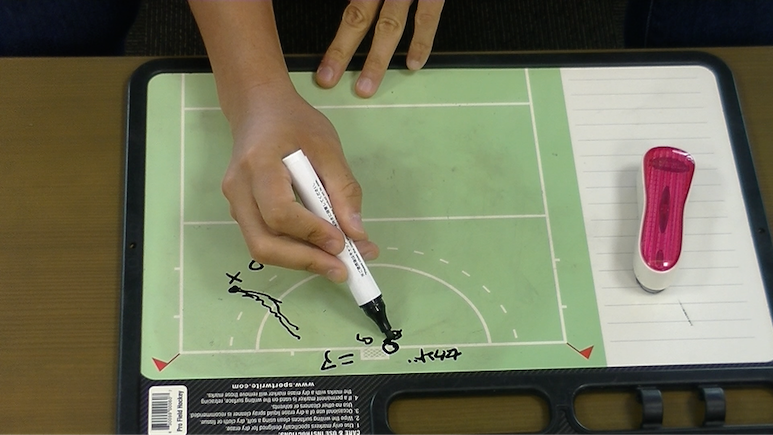
The reason is that the Hockey ball is small, and if it is a fast and strong ball, the Far Post is an easy place for the ball to come loose if there are few opponents, so they always have a more chance of scoring by being there. In other words, the Far Post is so important because if a player waits at the Far Post, he/she would score. So, even worldwide, I think it is a commitment within a team to always run or dive to the Far Post, when another player shoots.
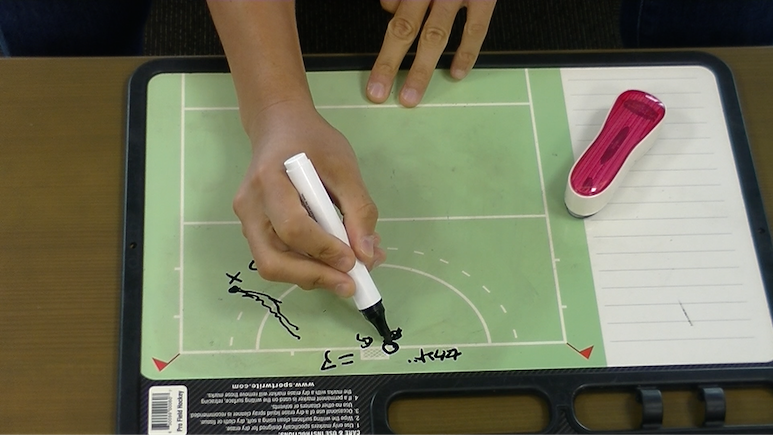
The Goalkeeper is unsure whether it is a direct shot to the goal or a touch shot because of the presence of an OF player at the Far Post, and if there is no one there, the Goalkeeper can focus on the direct shot, but if he/she thinks there is a possibility of a touch shot as well, he/she has to prepare to the both. But it is still difficult to read the intentions by looking at the face of the Hockey stick, because the ball is so fast.
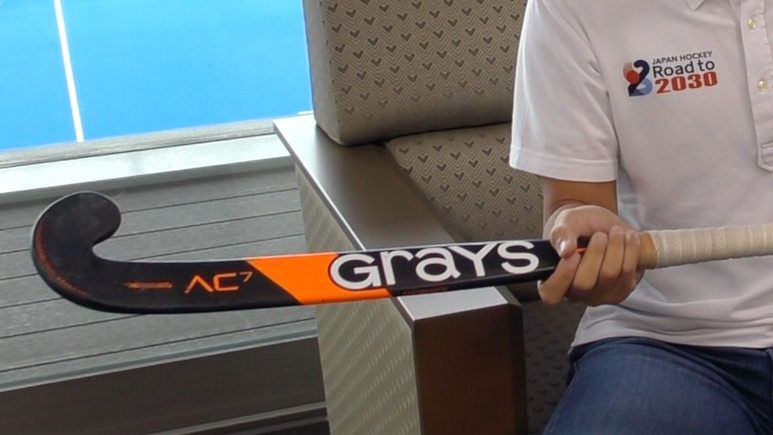
Then there is such effect of having someone at the Far Post like this. It is also often seen that “Someone deflects the ball and someone scores.”
For example, some OF player send the ball to a player coming here. But this place is not in front of the goal. Then this player hits the ball to here. At that time, there is always a teammate at the Far Post, so this teammate can shoot the ball just sent.
It is a very “Super Goal,” but in other words, it is a tactic where someone is always there.
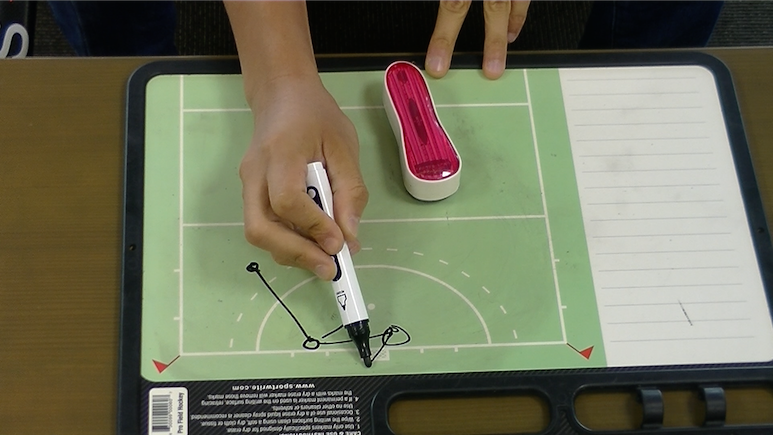
I think that they have a high level of awareness to create such form in the first place. When I watch videos of the top teams of the world, I really feel that there is a tendency to play such way because some player is surely to be there, rather than because they are lucky enough to have a player there. The whole team seems to have the same form in mind.
Part 5-3: Offense and Defense around the Circle – Concept of Defense (DF) –
As Offense (OF) does not attack from a narrow space, but does freely from a wide space, dribbling and so on, therefore, the basic idea of Defense (DF) is not allow OF to do so.
Priority #1: Drive OF players out of the Circle
In every team, DF defends the center of the pitch first. The theory is to defend the center, and even if an OF player goes outside, the first priority is to continue to defend the center.
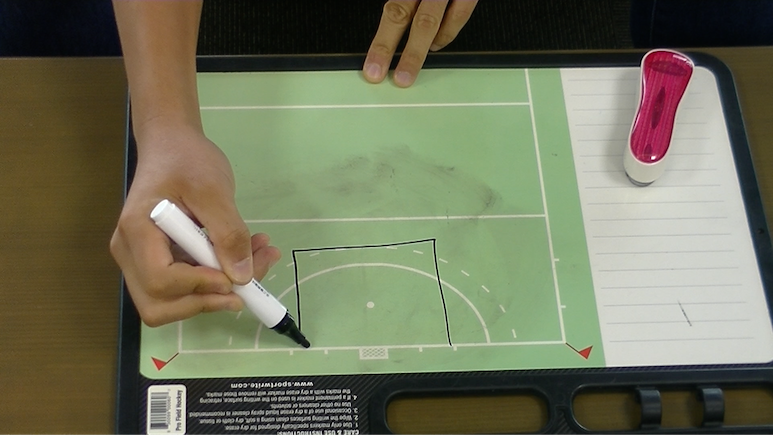
For example, when the ball is here and an opposing player goes to the outside and another opposing player is still center, DF player will not abandon the center and go to the outside. Well, it is not so dangerous to have the OF players outside. Rather, it is not so dangerous if the OF players go outside the Circle, so it is important for DF players to stay in place when such OF player goes outside and to protect the center so that the OF player at outside does not pass to the OF player at the center.
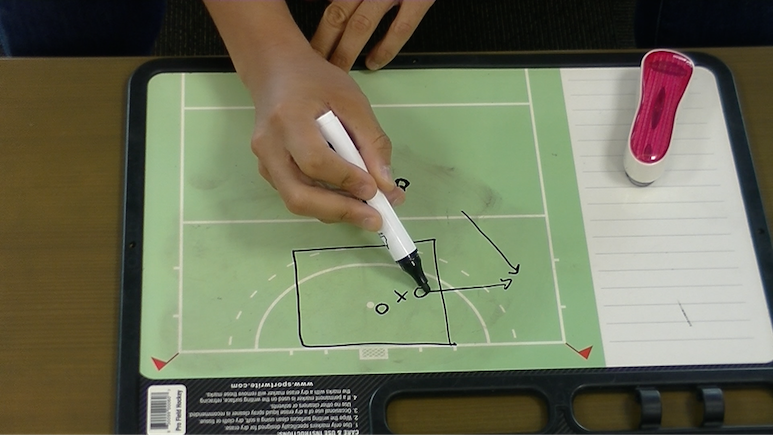
The theory of DF is to gather the DF players in the center in front of the goal and drive the opponents out, for example, when a teammate comes to support, this player shift to go outside to cover this OF player.
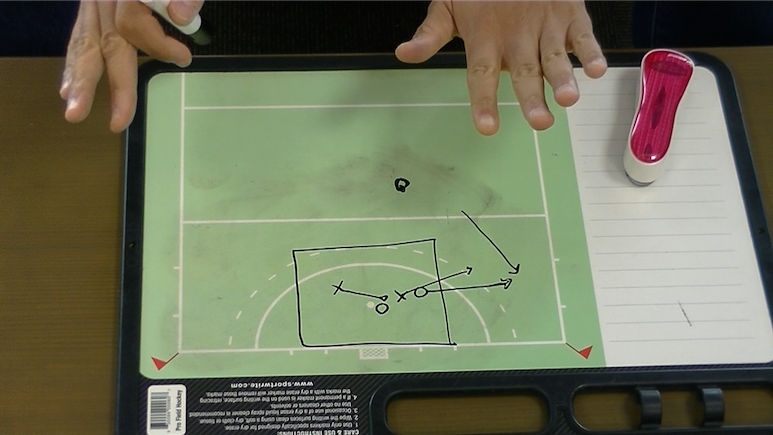
And, when an OF player keeps the ball here, DF tries to “put a lid” like this and to take the ball away here.

These “x” means the OF players, and when the ball is passed to this player, if DF player goes to cover him/her from this side, OF player will dribble to the other side like this, and, further more, if there is another OF player here, this player will return the ball to this player and deploy it to the opposite side, therefore, the first player should be cover from this side and another player is to support from this side. In detail, the first step is to cut off the path of this OF player by holding him/her down with the stick like this. Especially, to cut off the path to the back.
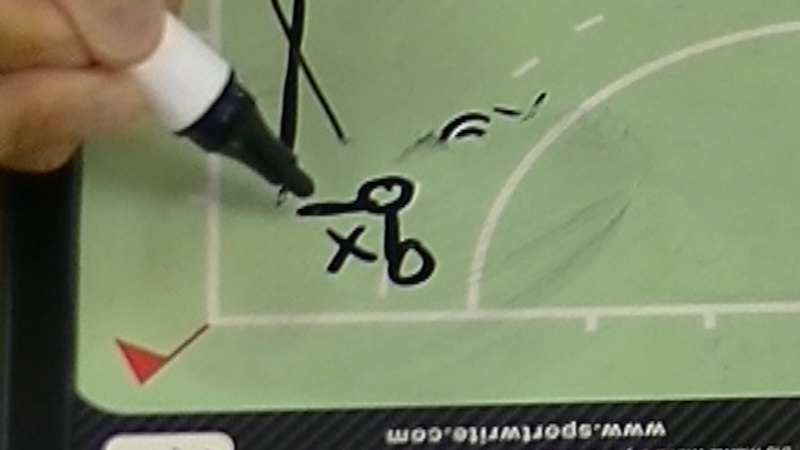
And, if, for example, there is an opponent here, then a DF player will cover this player. Then, this player would be isolated by eliminating the path of the pass. If there is an OF player here, another DF player will defend in this way. Thus, if there is another DF player, he/she will come close to them, and by creating “a Line” here with their bodies and sticks that will keep the opponent from going out, DF will intentionally drive the opponent here by blocking the pass course.
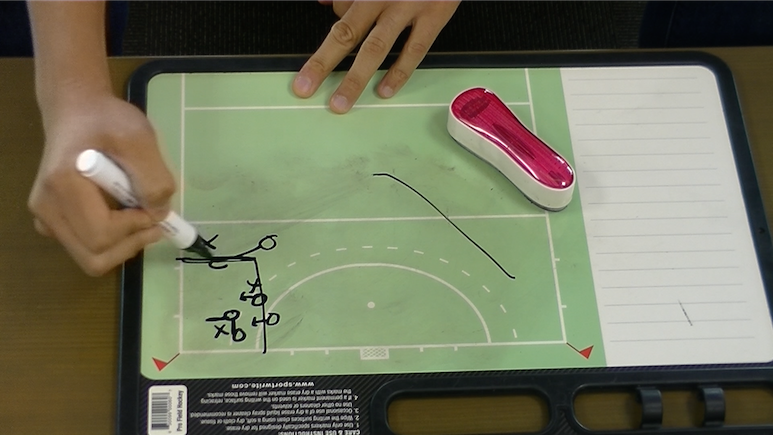
If the ball is connected to the opposite side of the pitch, the DF players must move, which is quite tough and also gives the opponent a chance to attack because the formation is out of place, therefore, it is important to cover the OF player firmly and to take the ball away. And by making a sure play to take the ball here, to drive the OF player out of the Circle is the first priority.
However, it is easier for the opponent to get the ball back if DF takes the ball away by this way. If the DF gets the ball here, it is best if they can connect the pass to their teammate, but if not, they try to take a Free Hit on the opponent’s foul as soon as DF takes the ball away. When they get a Free Hit, they can secure more time, and during that time, their teammates spread out around the pitch and the opponent will follow them, which creates a lot of space. Such “Strategic use of foul” play is common in Hockey.
Or, if DF player can “clear” the ball, he/she can scoop or hit the ball as hard as possible to recover the position. On the other hand, if DF player tries to connect the ball by force here, and the opponent will take the ball back and enter the Circle, which often leads to a goal or a Penalty Corner as the DF players are an inclination to this side.
So, when you watch a Hockey match, you may hear players say, “You can cut it.” It is often said to “cut the ball,” i.e., let’s get the ball out to the opponent’s area.
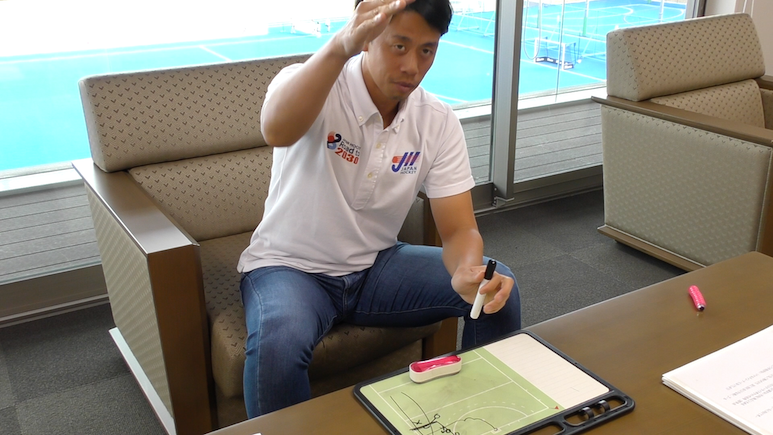
Priority #2: Utilize the less angled areas around the goal
The best thing for DF is to prevent OF from entering into the Circle by dribbling, but there are times when they do. Of course, depending on the physical ability of the opponent and the level of them, they may enter the Circle, but it is very important not to be impatient, especially in the Circle. Basically, the OF players hit the ball for shots as hard as they can and as soon as they turn around, which is quite fast and often fatal if the weight shift of the DF player is even slightly poor.
It is important not to be impatient in these “less angled” areas, because although the Circle has been entered, even if the OF player dribbles here, the probability of scoring from here is quite low.
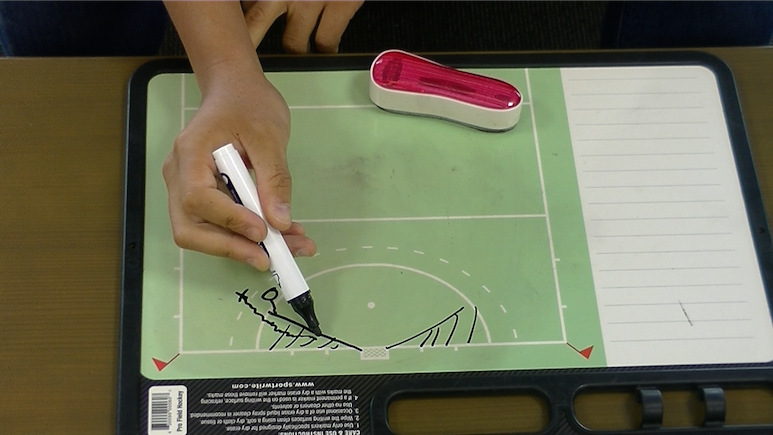
Therefore, as I said, not to be impatient is important because if a DF player tries to rush to get the ball in such “less angled” area, the ball is often hit on the foot and a Penalty Corner is awarded, resulting in a loss of goal, or, if DF player rushes in the Circle and challenge the opponent, OF player can go to the opposite way easily and can shoot or a Penalty Corner can be taken, so I have learned from my own experience that they have to be careful in such situations.
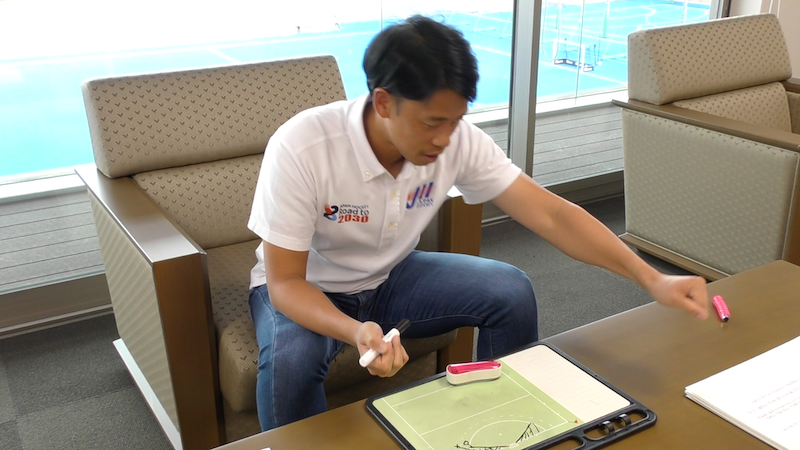
Share this content:
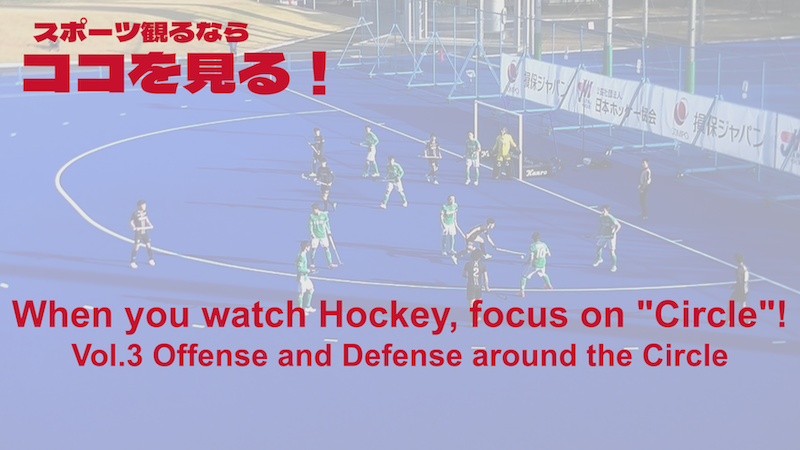
コメントを残す